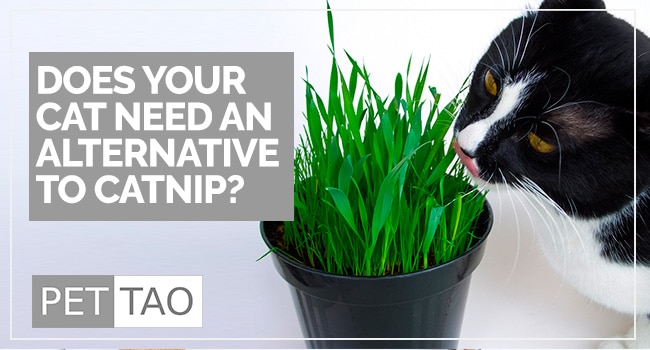Catnip, an aromatic herb also known as Nepeta cataria, is from the mint family. Native to North Africa and the Mediterranean, catnip is often given to cats as a stimulant.
Cats detect nepetalactone, the active ingredient in catnip, through their sense of smell.
Nepetalactone binds to smell receptors in your cat’s nose, activating receptors mimicking a cat’s “feel-good” pheromones.
After smelling catnip, you may notice your cat:
- Salivating
- Meowing
- Rubbing, leaping, or rolling in catnip
- Playing
- Relaxing
While some cats find catnip energizing, others experience stress relief.
Due to its stimulating properties, some cat owners give their overweight cats catnip to help them lose weight.
The effects of catnip last approximately 15 minutes. Catnip is non-addictive and cannot be “overdosed.”
Although catnip is well known as popular with cats, only about 50-60% of cats respond to it.
Luckily, there are catnip alternatives.
How Come Some Cats Don’t Respond to Catnip?
You may know a cat who doesn’t react when catnip is placed in front of him.
This is normal.
Catnip reactivity is conditional:
- Kittens younger than 3 months of age do not respond to catnip.
- If exposed to catnip too often, your cat may lose its ability to respond to it.
- The chemical in catnip is similar to the odor of a female cat in heat. Male tomcats are more affected by catnip than females.
- Genetics impacts your cat’s sensitivity to catnip. Dr. Cathy Lund of City Kitty Veterinary Care for Cats in Providence, RI, explains, “If your cat is one of the 50% of cats who are not sensitive to the herb, then it won’t have any appeal whatsoever.”
What are the Catnip Alternatives?
Valerian root (Valeriana Officinalis)
The active ingredient in Valerian root is actinidine. Cat owners add valerian to their pet’s food or stuff it in a toy.
Valerian has similar stimulating effects as catnip; however, it mimics the scent of cat urine. If the scent is too strong, other plants have the same attractant without the terrible smell.
Rats are also attracted to Valerian. In fact, in the story of the Pied Piper, he uses both pipes and valerian to attract rats.
Silvervine, Japanese Catnip or Matatabi (Actinidia Polygama)
Japanese catnip – also known as silvervine, Matatabi, and Actinidia Polygama – has a more powerful effect than traditional catnip.
Silvervine, a plant in the Kiwifruit family exported from Japan and China, is the most popular cat treat in Asia.
The active ingredient in Silvervine is the same found in Valerian – actinidine.
There is a Japanese saying about Silvervine. Roughly translated, it means “Silvervine to a cat, a coin to a prostitute,” or “To put someone in a good mood, give them their heart’s desire.”
Lemongrass (Cymbopogon citratus)
Lemongrass, a native herb from India and Sri Lanka, is also known as Cymbopogon citratus.
Although lemongrass is not available commercially, you can plant it in your garden.
Tatarian Honeysuckle (Lonicera Tatarica)
Some believe Tatarian Honeysuckle, also known as Lonicera Tatarica, produces a greater reaction than catnip. Tatarian Honeysuckle works on cats that do not react to catnip.
The active ingredient in Tatarian Honeysuckle is similar in structure to the nepetalactone found in catnip. However, unlike catnip, Tartarian honeysuckle has a better effect if is wet.
Use the sawdust shavings of honeysuckle, found at pet stores, and not the seeds or berries, which are toxic and cause stomach problems.
Cat Thyme (Teucrium Marum)
Cat Thyme, a small woody plant exported from Spain and the Western Mediterranean, is related to but is not a type of thyme.
However, Cat Thyme, which works like catnip, doesn’t grow as fast as catnip.
Acalypha Indica
Acalypha indica, also known as cat grass or Indian nettle, is a medicinal plant common in West Africa.
The effect of Acalypha indica is stronger than catnip, but only the root is attractive to cats.
Does your cat respond to catnip?
If not, now you know some catnip alternatives for your kitty cat.
Comment below and let us know!








